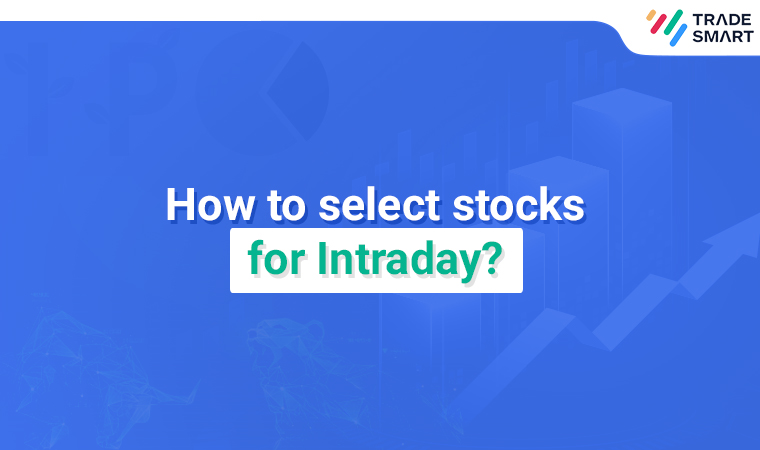How to Select Stocks for Intraday?
Feb 10 2022 4 Min Read

With the rise in market participants, the number of day traders are on the rise. As high as 60%-80% of the day’s volume comes from intraday trading activities. So what is it that is attracting a large number of participants to day trade more often than taking delivery of shares? Well, while it has its plus points like higher returns, lower overnight risk, and increased leverage which pulls many traders into it, day trading has some downsides too.
But when done within a well-defined framework with the right system and calculated risk, you can make the most out of day trading. So let us get down to knowing the process of selecting intraday stocks with the very basics first.
What is Intraday Trading?
Intraday trading, commonly known as day trading, involves buying and selling stocks within a day for speculation purposes. As the name suggests, the buy or sell orders are executed intraday before the stock market closes, that is on the same day as the corresponding buy or sell order was executed. Traders take intraday trades to avoid the risk of overnight change in the market sentiments. The goal of this type of trading is to track the movements of the stock prices and make quick gains from it.
How to Select Stocks for Intraday Trading?
We all know that picking stocks for long-term investment must have huge growth potential to create wealth. But the selection of scrips for short-term purposes such as intraday trading has a completely different list of requirements to fulfill. Below mentioned are some of the characteristics a stock must-have for you to buy and sell on the same day for gains.
-
Stock must be Highly Liquid
Liquidity means the ability to easily buy and sell. Since the intraday trader has to buy and sell the stock on the same day, the stock must be highly liquid to avoid problems in finding a potential buyer or seller at the time of squaring off the day’s position. Usually, liquid stocks have a huge trading volume that enables buyers to purchase and sell without affecting the price.
For example, if you took a long trade in Stock ABC but purchased it in the morning session, then you need to square off the position by selling the stocks before the market closes at 3:30 PM. If the stock is not liquid, then the number of active traders in that stock will be lesser and you will not find any buyers at the time of selling. Therefore, you must always look for stocks with a huge number of active buyers and sellers.
To identify the liquidity in stocks, must look at traded volume and refer to the market depth and watch for bid and offer price. The total number of bid and offer orders must be high and the gap between the nearest bid and offer price must be small.
-
Stock must be Volatile but not Too Volatile
The volatility of a stock is the rate at which the price moves during a given period. For a day trader to safely buy and sell the stocks on the same day, it is important to ensure that the stock prices are volatile. At the same time, you must also make sure that the price of that stock does not fluctuate too much as it can trigger your stop-loss levels very easily. Also, the less volatile stocks are not good for intraday trading since the prices don’t move much. Price movement is the main feature that a trader looks for in the stock to gain from it.
For example, suppose you buy 100 shares of Company X in the morning for Rs. 2000 per unit. The price of share X is not very volatile and by the afternoon it only went up to Rs. 2002. You used the capital of Rs. 2 Lakhs (100 shares x Rs. 2000 per unit) for this trade and earned only Rs. 200 (100 shares x Rs. 2 per unit) which is 0.1%. Even the trading charges are higher than this percentage. Therefore, you must select stocks that are volatile but not too volatile.
-
Stock must be Correlated with the Index
If you have been following the stock market for a while, you must have noticed that when the Nifty is up, most of the stocks are up and vice versa. This is because these stocks have a good correlation with the index. If the overall market sentiments are bullish, the stock prices go up and when the overall market sentiments are bearish, the stock prices fall.
As a day trader, you must select a stock that is positively correlated with the index as overall market sentiments will be in the favour of the price movements. Along with the index, positively correlated stocks benefit from the general market sentiments. For example, when the most awaited policy is announced by the Government, the overall stock prices go up except for a very few stocks. You should be on the side of the overall market sentiments.
Apart from these characteristics that the intraday stock must possess, there are certain other factors with the help of which you can select the stock to trade. They are:
-
Technical Analysis
There are certain indicators such as Moving Averages, MACD, Bollinger Bands, RSI, etc that help traders by indicating probable price movement. You can build a system using such indicators and when an ideal trade setup is generated in a particular stock, you can select that share for intraday trading.
-
News
Certain news such as the announcement of financial results, mergers, acquisitions, expansion of company’s operations, change in economic policies, etc. can create good intraday trading opportunities. You can pick stocks based on that. But you should be aware that price fluctuations on such stocks can be very high as the volatility increases before and after the announcement of the news.
The Bottom Line
Practice makes one perfect. Once you start with the selection process and begin your intraday trading, this checklist will become your instinct over time. The first and most important step in intraday trading is to select the right stock and therefore, you must exercise this task with utmost caution. Never jump into placing orders without proper study. The right stocks can make a huge difference in your trading performance. To make the best decisions, you must first analyze and then trade.
Frequently Asked Questions
Most of the index based stocks are liquid. To identify liquid stocks, you must notice their volume and the difference between the bid and offer price. If the gap between them is less, the stock is considered liquid.
The stock-specific news such as the company's financial results declaration strike or shut down, fire breakout in the factory, etc can impact the price. The general news such as economic policy by the Government, election results, trade wars between countries, etc. also affects the prices.
If the shares bought for intraday are not sold before the market ends, the brokers square off your positions at whatever price is available and a certain amount of penalty is charged. Some brokers also convert your intraday position into delivery based on the availability of funds in your account on request.
Compared to delivery-based trading, intraday trading is a little expensive. The charges such as brokerage, transaction charges, stamp duty, GST, etc are higher in case of intraday on most of the broker’s platforms.
Few shares have daily price swings wide enough to take intraday trades regularly. Therefore, it becomes necessary to have multiple stocks on the radar for intraday trading.




